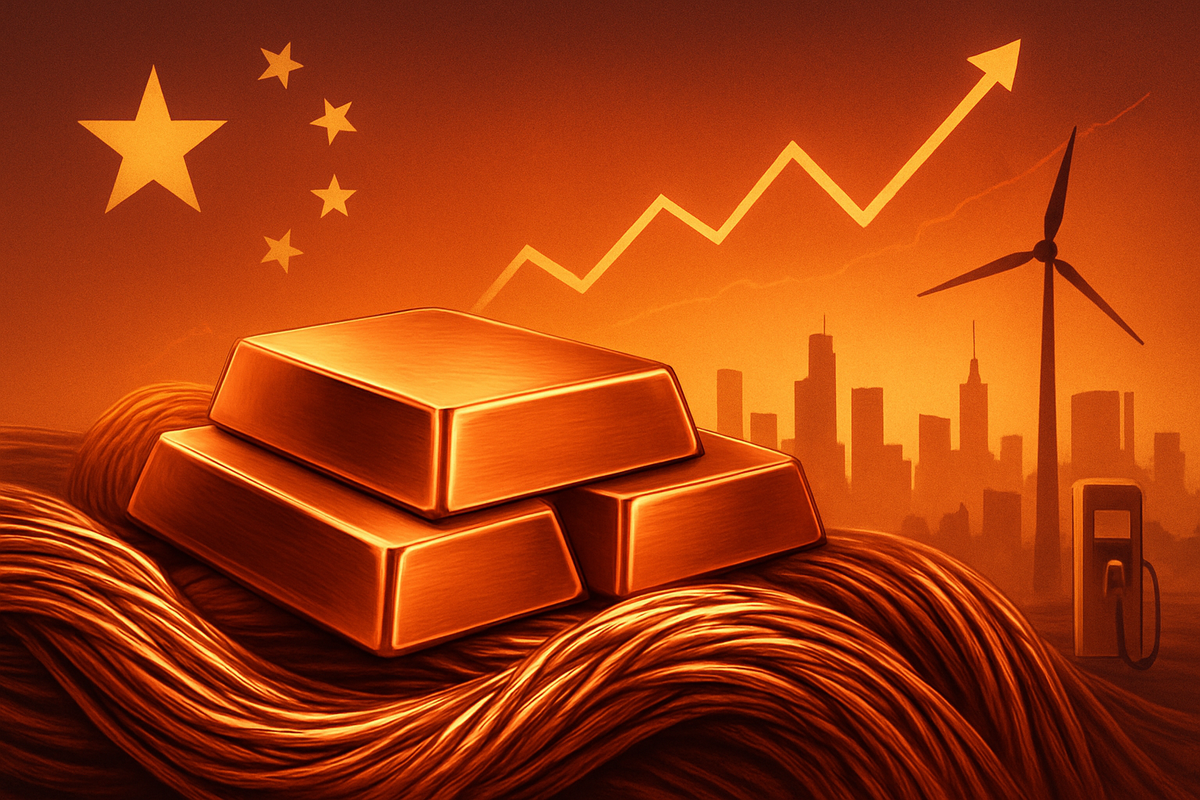
The global industrial metals market is witnessing a significant rally in copper prices, a surge primarily attributed to a renewed sense of optimism surrounding China's economic outlook. As of November 13, 2025, the "red metal" has become a bellwether for global economic health and the accelerating energy transition, with its price movements reflecting both robust demand fundamentals and persistent supply-side pressures. This upward trajectory signals a pivotal shift in the commodity landscape, impacting industries from manufacturing to renewable energy and prompting strategic re-evaluations across boardrooms worldwide.
The immediate implications of this copper price surge are far-reaching. For investors, copper has emerged as a critical commodity, with its rally outpacing many traditional investment assets and attracting unprecedented institutional interest. However, for industries reliant on copper, such as construction, manufacturing, and technology, the price increase translates directly into higher input costs, potentially affecting operational expenses and ultimately, consumer prices. The indispensable role of copper in the global energy transition means that higher prices also directly impact the cost and pace of decarbonization efforts, including the deployment of electric vehicles (EVs) and renewable energy infrastructure.
The Red Metal's Ascent: A Detailed Look at the Driving Forces
Copper prices have demonstrated extraordinary momentum throughout 2025. On the London Metal Exchange (LME), prices climbed to unprecedented levels of US$11,200 per tonne before stabilizing around US$10,800 per tonne as of November 11, 2025, representing a substantial 27% increase since January 2025. The COMEX copper futures reached an all-time high of US$5.81 per pound on July 23, 2025. In early November 2025, copper futures surged to $11,094 per tonne on the LME and $5.247 per pound on COMEX. As of November 13, 2025, copper was trading around $5.04 USD/Lbs, reflecting a 1.29% rise over the past month and a 23.94% increase compared to the previous year. JPMorgan Chase (NYSE: JPM) forecasts further upside, projecting prices to reach US$12,000 per tonne in the first quarter of 2026.
This significant rally is underpinned by several key factors, with China's renewed economic optimism taking center stage. As the world's largest consumer of copper, accounting for nearly 60% of global refined copper consumption, China's economic health directly dictates global copper demand and prices. The optimism stems from a series of government stimulus measures introduced in September 2024, aimed at addressing economic challenges like a prolonged property market slump and weak consumer confidence. These measures were anticipated to significantly boost industrial activity and, consequently, copper demand in 2025.
Further bolstering this positive outlook are improving economic data from China. October 2025 data showed easing deflationary pressures, with consumer prices turning positive (up 0.2% after two months of decline) and the producer price index seeing a narrowed decline (down 2.1% year-on-year, an improvement from September's 2.3% fall). These readings surpassed estimates, fostering confidence in an economic recovery. China's industrial sector also demonstrated strong resilience, with Q3 2025 industrial output surging 6.5% year-on-year, particularly driven by high-tech manufacturing and new-energy vehicle (NEV) production, both of which are highly copper-intensive. Resilient end-user copper demand and opportunistic exports by Chinese smelters capitalizing on pricing discrepancies further underscore the robust demand from the region.
Beyond China, persistent supply constraints are a critical factor. Global copper supply chains are under immense pressure due to operational disruptions, including labor strikes, weather-related delays, and extended maintenance at major mining operations in South America (Chile, Peru). Declining ore grades and insufficient investment in new mining capacity exacerbate these constraints. Notable disruptions in 2025, such as an incident at the Grasberg Mine and seismic issues at Kakula-Kamoa, have removed substantial production from global markets. The International Copper Study Group (ICSG) revised its 2025 mine-supply growth forecast downwards to 1.4%, highlighting deep structural constraints and a projected deficit of 150,000 metric tons in 2026. Geopolitically, the United States officially added copper to its critical minerals list in November 2025, recognizing its strategic importance for national security, clean energy, and advanced manufacturing, a designation expected to influence federal investment and project funding.
Winners and Losers: Corporate Fortunes in a Rising Copper Market
The surge in copper prices, driven by China's economic resurgence and global green energy demand, is creating a clear divide between beneficiaries and those facing increased cost pressures among public companies.
Companies That Stand to Win (Mining Sector): Copper mining companies are direct beneficiaries, as higher commodity values directly translate to enhanced revenues, expanded profit margins, and stronger cash flows.
- Freeport-McMoRan (NYSE: FCX): As a major global copper producer, Freeport-McMoRan directly benefits. Its stock has surged alongside copper prices, particularly after China's stimulus announcements. Its U.S. operations also benefit from domestic copper tariffs, creating a premium for COMEX copper over the LME benchmark.
- BHP Group (ASX: BHP): One of the world's largest copper producers, BHP is strategically positioned to capitalize on rising demand. The company reported a 4% year-on-year increase in group copper production in Q1 FY26 and is investing heavily in copper development, allocating nearly half of its total capital expenditure to the metal.
- Rio Tinto (ASX: RIO): Another mining giant, Rio Tinto is also set to benefit, with a 10% increase in Q3 2025 copper output compared to the previous year. Its Oyu Tolgoi mine is a key performer, and the company maintains a strong conviction in long-term copper fundamentals.
- Glencore (LSE: GLEN): While typically a beneficiary, Glencore's situation is more nuanced due to declining copper production for four consecutive years. However, rising copper prices have provided some recent support to its share price, and the company is working on organic growth projects to restore production levels.
Companies That Might Lose or Be Negatively Affected (Manufacturing, EV, Electronics): Companies heavily reliant on copper as an input material face increased production costs, which can erode profit margins or necessitate price increases.
- Tesla, Inc. (NASDAQ: TSLA) and other Electric Vehicle (EV) Manufacturers (e.g., General Motors (NYSE: GM), Ford Motor Company (NYSE: F)): EVs are "copper gluttons," using significantly more copper (around 180 pounds per vehicle for a Tesla) than traditional cars. This makes EV manufacturers highly vulnerable to copper price increases, directly driving up production costs by several hundred dollars per vehicle.
- Samsung Electronics (KRX: 005930) and other Electronics Companies: The semiconductor industry and broader electronics manufacturing rely on copper for wiring, processors, and cooling systems. Rising copper prices, especially compounded by tariffs, can lead to increased manufacturing costs, supply chain disruptions, and potential delays.
- General Electric (NYSE: GE) and Siemens (ETR: SIE) (Industrial Manufacturing): Large industrial manufacturers that produce equipment requiring substantial amounts of copper wiring and components (e.g., power generation, transformers) will face increased input costs. Sustained high copper prices could squeeze margins on new projects or require them to pass costs onto customers.
Unique Case: Prysmian Group (BIT: PRY) (Cable Manufacturing): As the world's largest cable maker, Prysmian Group is a "relative tariff winner" amidst U.S. copper tariffs. The company sources 90% of its U.S. copper domestically and processes it at its Texas mill, shielding it from import tariffs. This vertical integration, strengthened by its acquisition of Encore Wire (NASDAQ: WIRE) in 2024, allows it to mitigate negative impacts and even benefit in certain markets, often passing on costs through long-term utility contracts.
Wider Significance: A New Copper Supercycle Emerges
The current surge in copper prices is not merely a cyclical uptick; it represents a profound shift with wider significance, fitting into broader industry trends and signaling the advent of a "new copper supercycle." This supercycle is distinguished by its global reach, a broader range of demand sectors, and its intertwining with national security concerns and environmental policies.
The most significant underlying trend driving copper demand is the global push towards clean energy. Copper's exceptional electrical conductivity makes it indispensable for electric vehicles, renewable energy infrastructure (solar panels, wind turbines), and grid modernization. EVs require significantly more copper than traditional cars, and the expansion of EV charging infrastructure further boosts demand. Renewable energy technologies demand approximately five times more copper than conventional systems. Moreover, AI infrastructure and data centers are emerging as substantial new consumers of copper for power distribution and cooling, adding another powerful demand vector.
Ripple effects are evident across various sectors. The electronics industry, fundamental to modern life, faces increased raw material and operational costs, which are often passed on to consumers. The construction industry, a traditional copper consumer, will see elevated project costs, potentially leading to budget overruns and delays. The wire and cable industry, a direct consumer, is also acutely affected, with some manufacturers already increasing prices. These rising costs contribute to global inflationary pressures, particularly in developing economies, straining household budgets. The economic pressure is also accelerating research into material substitution, with industries exploring alternatives like aluminum where feasible, representing a significant long-term shift.
Regulatory and policy implications are increasingly prominent. Stricter environmental regulations aimed at mitigating the impact of mining operations are increasing compliance costs and constraining supply. Geopolitical factors and trade policies significantly impact the market; the LME and CME's embargo on Russian copper has contributed to supply imbalances. Furthermore, the prospect of new tariffs, such as the U.S. Administration's announced potential 50% tariff on imported copper effective August 1, 2025, has already caused U.S. copper futures to soar, creating higher costs for U.S. manufacturers and disrupting supply chains. Governments, recognizing copper's strategic importance, are also utilizing strategic stockpiles and encouraging massive investments in new mine development and technological innovation.
Historically, copper prices have exhibited cyclical patterns, often reflecting global economic growth. Past surges occurred during World War I and II due to heightened industrial demand, and during the digital revolution. However, the current rally, particularly since 2023, is marked by the unprecedented scale of demand from the simultaneous global energy transition and the build-out of AI infrastructure, combined with persistent structural supply issues and specific geopolitical interventions. Analysts suggest this confluence of factors may lead to sustained higher prices, unlike earlier cycles where high prices often quickly led to a supply boom and price reversion. The long-term outlook for copper, particularly from 2027 and beyond, is overwhelmingly bullish, with projections of significant supply shortfalls by 2030 and 2035.
What Comes Next: Navigating the Copper Horizon
The global copper market, energized by recent price increases and renewed Chinese optimism, faces a dynamic and complex future from November 2025 onwards. While short-term volatility is possible, the long-term outlook remains overwhelmingly bullish due to unprecedented demand from the global energy transition and persistent supply challenges.
In the short-term (late 2025 - 2026), price movements are mixed but largely strong. While some analysts anticipate a modest dip before stabilization, others foresee continued robustness, with UBS (SWX: UBSG) predicting copper to reach $11,000/metric tonne by September 2026, and Goldman Sachs (NYSE: GS) raising its 2026 forecast to $10,500/ton. Supply dynamics will see global mine copper production increase by approximately 2.3% in 2025, driven by ramp-ups at large projects like Kamoa-Kakula (DRC) and Oyu Tolgoi (Mongolia). However, this growth will be constrained by declines elsewhere, and a significant shortage of concentrates, exacerbated by the shutdown of the Cobre Panama mine, could lead to a 1.5% decline in refined copper production by 2026. China remains a crucial demand driver, with its industrial resilience, particularly in high-tech manufacturing and New Energy Vehicle (NEV) production, continuing to stimulate copper consumption. The International Copper Study Group (ICSG) initially forecast a surplus, but this outlook is increasingly challenged, with many analysts predicting a global refined copper market deficit in 2025 and 2026.
Looking further ahead (beyond 2026), the long-term possibilities for copper are characterized by accelerating demand and persistent supply deficits. Copper demand is projected to double by 2035, from approximately 25 million tonnes annually today, and continue to grow thereafter, potentially reaching 49 million tonnes by 2050. Clean energy technologies are expected to account for over 50% of global copper demand by 2040. This demand acceleration will be driven by electric vehicles, renewable energy, grid infrastructure, and the rapidly expanding AI and data center sectors. A significant and persistent supply-demand imbalance is projected to emerge as early as 2025 and last through most of the following decade, or even the 2030s. This widening gap is due to long mine development timelines (10-17 years), declining ore grades, underinvestment in new projects, and geopolitical/environmental hurdles. Analysts project a potential annual shortfall of 6-10 million tonnes by 2035, with some studies indicating that 80 new sizable copper mines will be needed by 2040 to meet demand. Long-term price projections are strongly bullish, with prices potentially ranging from $12,500-$15,400/tonne by 2028-2030, and even higher in the very long term.
To address this impending supply gap and capitalize on the bullish long-term outlook, strategic pivots are emerging. Mining companies are prioritizing exploration, expansion, and M&A activity to secure future copper supplies, with companies like Teck Resources (TSX: TECK.B) divesting from legacy commodities to focus on copper. Governments, such as the U.S., are designating copper as a critical mineral to incentivize investment and accelerate projects. Industries and investors are increasingly engaging in direct investment in mining companies and advanced recycling infrastructure to secure supply chains. These strategic shifts aim to mitigate challenges like the structural supply deficit, long lead times, operational risks, and rising costs, while capitalizing on opportunities presented by decarbonization, robust Chinese demand, and technological advancements. Potential scenarios range from a "Green Supercycle" with sustained upward pressure on prices, to "Volatile Consolidation" with short-term corrections, and a high-risk "Supply Shock" scenario leading to extreme price spikes and demand destruction.
The Dawn of a "New Copper Age": A Comprehensive Wrap-up
The global copper market is firmly entrenched in a pivotal "New Copper Age," characterized by its indispensable role in the global energy transition and a looming structural supply deficit. As of mid-November 2025, copper prices reflect this reality, demonstrating significant gains and positioning the metal as a strategic resource rather than a merely cyclical commodity.
The key takeaways from the current market are clear: severe supply constraints, evidenced by disruptions at major mines like Freeport's Grasberg and Kamoa-Kakula, coupled with exceptionally low LME inventory levels, are tightening the market. This is occurring amidst robust demand drivers, particularly from China's renewed economic activity and the surging needs of the energy transition. Copper prices have responded accordingly, with substantial year-on-year increases and bullish forecasts from leading financial institutions.
Moving forward, the market consensus points to a bullish outlook for copper prices through 2026 and beyond. A structural deficit is widely anticipated to emerge, driven by an inelastic supply response—new copper projects take over a decade to materialize—and accelerating demand from electric vehicles, renewable energy, grid modernization, and AI infrastructure. Macroeconomic tailwinds, including a projected global economic pick-up and potential U.S. interest rate cuts, are expected to provide further support. China's economy, poised for a rebound in the coming year, will continue to be a significant catalyst, particularly through its ambitious renewable energy targets.
The lasting impact of this "New Copper Age" is profound. The International Energy Agency (IEA) estimates that achieving net-zero emissions by 2050 could drive annual copper demand to 40 million tons, nearly doubling current levels. S&P Global projects annual copper supply deficits could exceed 10 million tons by 2035, representing a 20% gap between projected demand and current capacity. Copper is undeniably the backbone of the global economy's transition to a greener future, underpinning every electric vehicle, solar panel, 5G tower, and data center. This sustained demand and anticipated higher prices are crucial to incentivize desperately needed investment in new mining projects and recycling efforts, driving a focus on sustainability and innovation within the industry.
For investors, the coming months will require close attention to several key factors. Monitoring supply resilience and potential disruptions at major mine operations, particularly in politically sensitive regions, will be critical. The health of the global economy, especially China's, remains paramount, with any signs of slowdown potentially tempering forecasts. Inventory movements on major exchanges like the LME and Shanghai Futures Exchange (SHFE) will provide immediate indicators of market tightness. Furthermore, shifts in trade policies, such as tariffs, and geopolitical stability in copper-producing nations can significantly impact supply chains and price flows. Finally, observing investment trends in copper-rich areas and advancements in recycling technologies will offer insights into the long-term supply picture. Despite short-term risks and price volatility, the overarching narrative for copper is compelling, positioning it as a strategic asset in the years to come.
This content is intended for informational purposes only and is not financial advice





